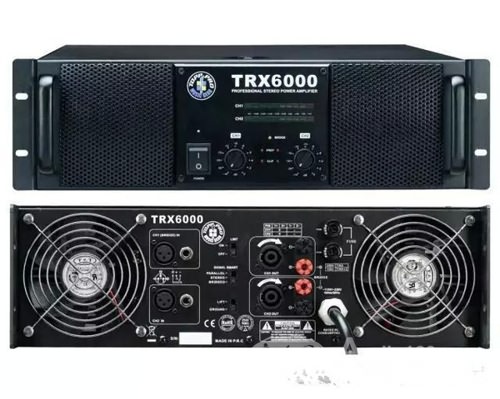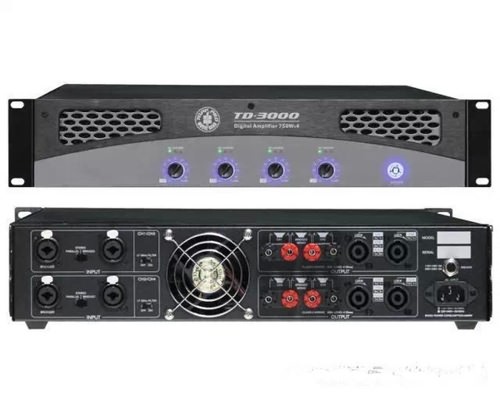First of all, according to different amplification types of power amplifiers can be divided into:
Class A (Class A is also called Class A), Class B (Class B is also called Class B), Class AB (Class AB is also called Class A), and Class D (Class D is also called Digital).
1, pure class A power amplifier
In the field of audio, people have been sticking to the position of Class A amplifiers. It is considered that the sound of Class A amplifier is the most fresh and transparent, with high fidelity. However, the inefficiency and high loss of Class A power amplifiers are innate ills that it cannot overcome. A pure class A power amplifier, also known as a Class A power amplifier (Class A), is a fully linear amplifier form of the amplifier. When a pure Class A power amplifier is operating, the positive and negative channels of the transistor are normally open regardless of the presence or absence of a signal, which means more power is dissipated as heat, but the distortion rate is extremely low. Pure Class A power amplifiers are rare in automotive audio applications, such as the JET CITY Advanced Series in the United States. This is because the efficiency of a pure class A power amplifier is very low, usually only 20-30%, but audiophiles are relishing its sound.  2. Class B power amplifier
2. Class B power amplifier
Class B power amplifiers, also known as Class B power amplifiers (Class B), are also known as linear amplifiers, but they work in a completely different way than pure Class A power amplifiers. When class B power is put into operation, the positive and negative channels of the transistor are usually in the off state unless there is signal input, that is, only the positive phase channel works when the positive phase signal comes, and the negative phase channel is closed. It won't work at the same time, so there is no power loss in the part without signal. However, when the positive and negative channels are turned on and off, crossover distortion is often generated, especially in the case of low level. Therefore, the class B power amplifier is not a high-fidelity power amplifier in the true sense. In practical applications, in fact, early Many car audio amplifiers are Class B amplifiers because of their high efficiency. Although the efficiency of Class B power amplifier is much improved, the actual efficiency is only about 50%. In small portable audio equipment such as car amplifiers, notebook audio systems and professional super power amplifiers, the efficiency is still unsatisfactory. Therefore, the highly efficient Class D power amplifier is receiving attention from all quarters because it conforms to the trend of the green revolution.
Due to the development of integrated circuit technology, very complicated modulation circuits originally made with discrete components are now no problem in terms of technology and price. Moreover, in recent years, the development of digital audio technology, people have found that Class D power amplifiers and digital audio have many similarities, further showing the development advantages of Class D power amplifiers.
3. Class A and B power amplifiers
Class A and B power amplifiers, also known as Class AB power amplifiers (Class AB), are a design that is compatible with Class A and Class B amplifiers. When there is no signal or the signal is very small, the positive and negative channels of the transistor are always open, and the power is lost, but there is no serious class A power amplifier. When the signal is positive, the negative phase channel is normally open before the signal becomes strong, but the signal is strong and the negative channel is closed. When the signal is a negative phase, the positive and negative channels work just the opposite. The disadvantage of the class AB power amplifier is that it will produce a little bit of crossover distortion, but it is superior to the class A and class B power amplifiers in terms of its efficiency ratio and fidelity. The class AB power amplifier is also the most widely used in the market. The design, such as the TOPP PRO American Top TRX series, uses the AB design.  4, digital amplifier
4, digital amplifier
Class D power amplifiers are an amplification mode in which the amplifying element is in the operating state of the switch. When there is no signal input, the amplifier is in the off state and does not consume power. In operation, the transistor is brought into saturation by the input signal, and the transistor is equivalent to an on-switch, which directly connects the power supply to the load. An ideal transistor consumes no power because it has no saturation voltage drop. In fact, the transistor always has a small saturation voltage drop and consumes some of the power. This power consumption is only related to the characteristics of the tube, and is independent of the size of the signal output, so it is particularly advantageous for ultra-high power applications.
In an ideal situation:  Class D amplifiers have an efficiency of 100%.
Class D amplifiers have an efficiency of 100%.
Class AB amplifiers have an efficiency of 78.5%.
The efficiency of A or B power amplifiers is only 25% or 50% (depending on the load method).
Class D amplifiers actually only have a switching function, and were only used in switching control circuits for actuators such as relays and motors. However, the switching function (that is, the function of generating digital signals) has been increasingly developed with the development of digital audio technology, and the road of amplification with Hi-Fi audio has become increasingly smooth. In the 1960s, designers began to study Class A amplifiers for audio amplification. In the 1970s, Bose began producing Class D car amplifiers. On the one hand, automotive battery power supply requires higher efficiency. On the other hand, space is small and cannot be placed in a power amplifier with a large heat sink structure. Both of them hope to have such an efficient amplifier as Class D to amplify the audio signal. One of the key steps is the modulation of the audio signal.
The working principle of the power amplifier is actually very simple, that is, the various sound signals played by the sound source are amplified to push the sound of the speaker. From a technical point of view, a power amplifier is like a current modulator, which converts alternating current to direct current, and then is controlled by the sound signal played by the sound source, and transmits different currents to the speaker according to different frequencies, so that the speaker is correspondingly The sound of the size and the corresponding frequency. Due to power, impedance, distortion, dynamics, and different ranges of use and control adjustments, different power amplifiers have different internal signal processing, circuit design, and manufacturing processes. According to the current demand for audio consumption, the amplifiers in civilian audio have been basically shaped into two categories, namely pure music amplifiers and home theater av amplifiers.
5, pure music amplifier
The pure music amp design emphasizes the lowest signal distortion, faithfully shows the scene, details and performance of the music, recording skills to meet people's best appreciation of music requirements, which is often said hi-fi (hi- Fidelity, high fidelity). Pure music amplifiers are extremely demanding in design and production. The quality of a pure music amplifier is not completely determined by its technical indicators. It cannot be simply seen how high the power it marks, how wide the frequency response, and how low the distortion is, but should pay special attention to its design and production process and the clarity of music. For example, a amp that is not too high in technical specifications is better than many transistor amps.
6, av amplifier
It generally includes a power amplifier section and a signal processing section. The principle of the power amplifier is no different from the traditional power amplifier, except that several channels are added, that is, several power amplifiers are combined together; the signal control processing part involves signal audio, video selection, signal decoding processing, and signal. Sound field processing and radio, monitor and other functions.
Generally, a high-quality av power amplifier should first have a better sound field reduction in the signal processing of film and television programs, the channel isolation is high, and the atmosphere rendering can not be too exaggerated; secondly, the sound quality performance of the power amplifier part, especially the main The sound quality of the channel is as close as possible to a better pure music amplifier.
7, the classification of power amplifier
The power amplifier is generally divided into a pre-amplifier, a post-amplifier and a merge-level amplifier. The merger is a machine that combines the pre-stage and the post-stage. The front stage is used to initially amplify and adjust the volume; while the latter stage is to amplify the signal from the previous stage to drive the speaker.
The pre-stage is also divided into active and passive. The active front stage uses a power supply to amplify the signal, while the passive front stage only regulates the volume. Honestly, there are not many passive pre-stages that are successful today, because the internal resistance of the sound source and the rear stage are very different. Only one volume switch is used to connect the sound source to the rear stage. The difference of internal resistance will make dynamic, detail, and frequency. It should be lost! In addition to adjusting the volume, the active front stage can also be used as a buffer for the majority and lowering the internal resistance between the sound source and the latter stage.
The latter stage is to amplify the signal from the previous stage to the speaker, and the latter stage must be sufficient to push the speaker. The so-called power is not the greater the sound. Must have the ability to support the entire scene of the orchestra without losing its details.
Separating the front and back levels is better than the merger, because each has more space to make it more sophisticated. There is less interference between the two, and the details are more; moreover, there are more choices for the promoters before and after the separation, and more things can be played.
Half-cell Polycrystalline Solar Panel
Half-Cell Polycrystalline Solar Panel,340W Half Cell Solar Panel,High Efficiency Polycrystalline Solar Cell Panel,Half-Cell Poly Solar Panel
Jiangsu Stark New Energy Co.,Ltd , https://www.stark-newenergy.com